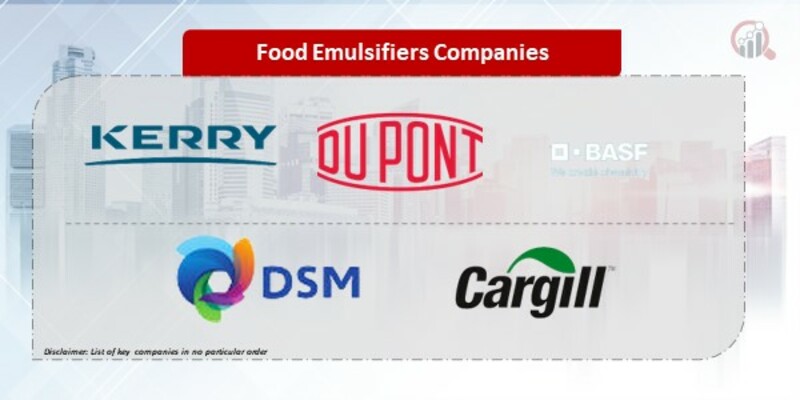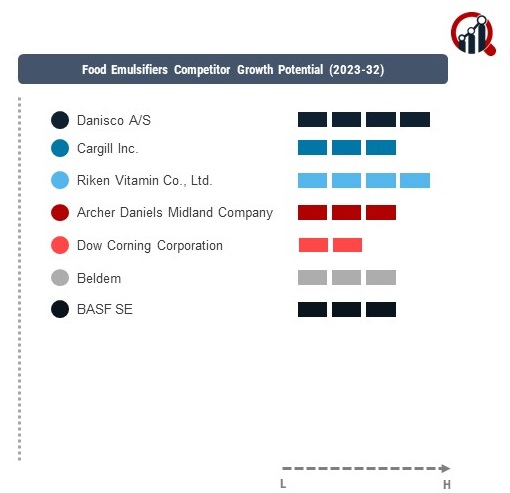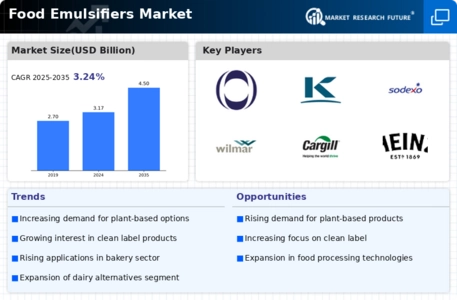Top Industry Leaders in the Food Emulsifiers Market

Strategies Adopted by Food Emulsifiers Key Players
The food emulsifiers market is witnessing intense competition as manufacturers strive to capitalize on the growing demand for processed and convenience foods. The competitive landscape is characterized by key players adopting strategic measures to enhance market presence, expand product portfolios, and gain a competitive edge. In this analysis, we delve into the strategies adopted by key players, factors influencing market share, emerging companies, industry news, and the overall competitive scenario.
Key Players:
Kerry Group (Republic of Ireland)
Evonik Industries AG(Germany)
DowDuPont (U.S.)
BASF SE (Germany)
Clariant (Switzerland)
Koninklijke DSM N.V. (The Netherlands)
Akzonobel N.V. (The Netherlands)
Cargill Incorporated (U.S.)
Lonza(Switzerland)
Solvay SA (Belgium)
Stepan Company (U.S.)
The Lubrizol Corporation (U.S.)
- Product Innovation: Key players consistently invest in research and development to introduce novel and improved emulsifiers. Innovation remains a core strategy to cater to changing consumer preferences, address health concerns, and enhance the functional properties of food products.
- Strategic Partnerships and Collaborations: Companies are actively engaging in partnerships and collaborations with food manufacturers to understand market needs better. These alliances facilitate the development of customized emulsifiers and provide a competitive advantage in terms of market reach and distribution.
- Mergers and Acquisitions: Mergers and acquisitions are prevalent strategies to expand market presence and acquire technological expertise. Key players are strategically acquiring smaller companies to strengthen their product portfolios and gain a foothold in emerging markets.
Market Share Analysis:
- Product Portfolio and Diversification: The breadth and depth of product portfolios play a crucial role in determining market share. Companies with diverse emulsifier offerings covering various applications and industries are better positioned to capture a larger market share.
- Geographic Presence: The global nature of the food emulsifiers market demands a strong international presence. Companies with a well-established distribution network and local partnerships can effectively penetrate and dominate different regional markets.
- Research and Development Investments: Continuous investment in research and development ensures the development of innovative emulsifiers, aligning with market trends. Companies allocating resources to stay at the forefront of technological advancements are likely to command a larger market share.
New & Emerging Companies:
- Corbion N.V.: Corbion is an emerging player in the food emulsifiers market, focusing on sustainable solutions. The company has gained attention for its bio-based emulsifiers, catering to the increasing demand for clean label and environmentally friendly ingredients.
- Lonza Group: Lonza, a Swiss multinational, is making strides in the food emulsifiers sector with its emphasis on quality and safety. The company is gaining recognition for its emulsifiers designed to enhance shelf life and stability in a variety of food products.
Industry Trends:
Recent industry developments and investment trends underscore the dynamic nature of the food emulsifiers market. Companies are increasingly investing in sustainable practices, exploring clean label solutions, and aligning with consumer demands for healthier food options. Notable trends include the adoption of advanced technologies in production processes, ensuring efficiency and cost-effectiveness.
Competitive Scenario:
The food emulsifiers market remains competitive, with established players navigating a landscape shaped by evolving consumer preferences, stringent regulations, and technological advancements. The emphasis on sustainability, clean label ingredients, and product differentiation will continue to drive the competitive dynamics of the market.
Recent Development
The food emulsifiers market witnessed several notable developments. Many key players introduced emulsifiers with enhanced functionalities, catering to the specific needs of the bakery and confectionery sectors. Additionally, a surge in demand for plant-based emulsifiers prompted major companies to invest in research aimed at developing sustainable and plant-derived alternatives. Strategic collaborations between key players and regional distributors also marked a trend, facilitating efficient market penetration and addressing local preferences.










